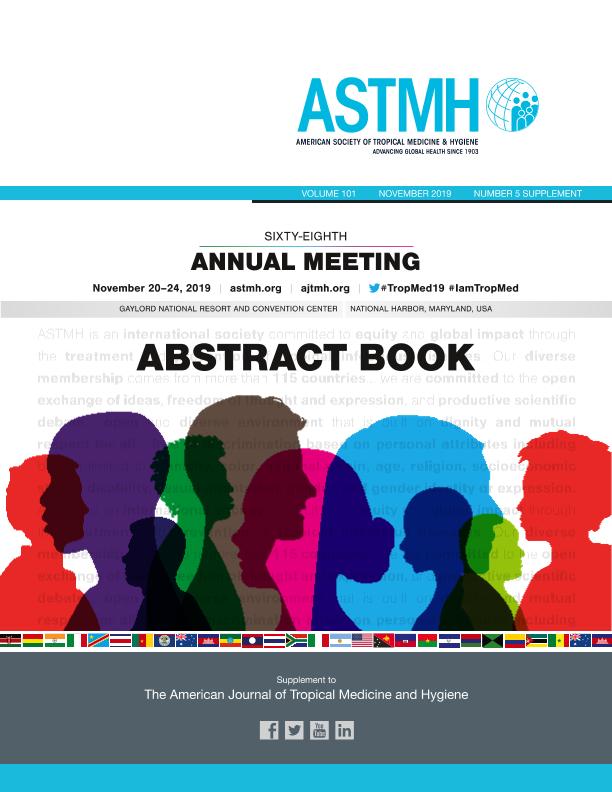Evento
Dengue fever, Aedes aegypti and climate dynamics from the temperate city of Córdoba, Argentina, during the time series of 2009-2017
Estallo, Elizabet Lilia ; Grech, Marta Gladys
; Grech, Marta Gladys ; Ludueña Almeida, Francisco; Benitez, Elisabet Marina
; Ludueña Almeida, Francisco; Benitez, Elisabet Marina ; Ainete, M.; Almiron, Walter Ricardo
; Ainete, M.; Almiron, Walter Ricardo
 ; Grech, Marta Gladys
; Grech, Marta Gladys ; Ludueña Almeida, Francisco; Benitez, Elisabet Marina
; Ludueña Almeida, Francisco; Benitez, Elisabet Marina ; Ainete, M.; Almiron, Walter Ricardo
; Ainete, M.; Almiron, Walter Ricardo
Tipo del evento:
Congreso
Nombre del evento:
68° Annual Meeting of American Society of Tropical Medicine and Hygiene
Fecha del evento:
20/11/2019
Institución Organizadora:
American Society of Tropical Medicine and Hygiene;
Título del Libro:
Abstract Book of 68° Annual Meeting of American Society of Tropical Medicine and Hygiene
Editorial:
American Society of Tropical Medicine and Hygiene
Idioma:
Inglés
Clasificación temática:
Resumen
Argentina is located at the southern range of arboviral transmissionby Aedes aegypti and has experienced a rapid increase in arbovirus transmission in recent years. The aim of this study was to present, for the first time, the methods and findings from a prospective long-term entomological surveillance study that began in 2009 in the city of Córdoba, following the first dengue virus (DENV) outbreak. We analyze the seasonal and interannual dynamics of DENV transmission in the city, in relation to Ae. aegypti indices and local climate. Therefore, from 2009 to 2017, larval surveys were conducted monthly, from November to May, in 600 randomly selected households distributed across the city. From 2009 to 2013, ovitraps (n=177) were sampled weekly to monitor the oviposition activity of Ae. aegypti. Cross correlation analysis was usedto identify significant lag periods between climate, entomologic and epidemiologic variables. Climate, entomologic and epidemiologic variables exhibited a strong seasonal pattern with a single peak within the year (climate, epidemiologic) or sampling period (entomologic). The largest correlation between autochthonous dengue and minimum temperature was at 9 weeks (positive), and there was a large positive correlation between autochthonous dengue and relative humidity (minimum, mean, maximum) at 4 weeks. There was a positive correlation with meanrelative humidity at lag 4 in 2009, and a negative correlation between ovitrap positivity and minimum relative humidity at lag 2 in 2010. Ovitrap positivity was positively correlated with relative humidity (mean, maximum) and precipitation at a 5-week lag and negatively correlated with mean temperature in 2012. This prospective entomological surveillance study provides the first evidence that Ae. aegypti larval indices in this temperate region have increased over the last 9 years, a period when arboviral diseases have become epidemic for the first time. These findings suggest an increasing the risk of arbovirus emergence and sustained transmission at temperate southern latitudes, where these diseases were not previously reported.
Archivos asociados
Licencia
Identificadores
Colecciones
Eventos(CIEMEP)
Eventos de CENTRO DE INVESTIGACION ESQUEL DE MONTAÑA Y ESTEPA PATAGONICA
Eventos de CENTRO DE INVESTIGACION ESQUEL DE MONTAÑA Y ESTEPA PATAGONICA
Citación
Dengue fever, Aedes aegypti and climate dynamics from the temperate city of Córdoba, Argentina, during the time series of 2009-2017; 68° Annual Meeting of American Society of Tropical Medicine and Hygiene; Maryland; Estados Unidos; 2019; 56-57
Compartir



